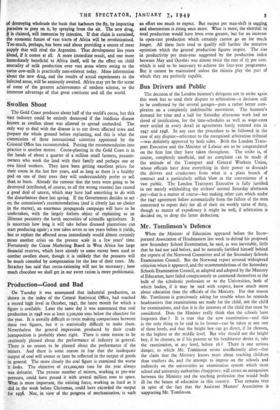Production—Good and Bad
On Tuesday it was announced that industrial production, as shown in the index of the Central Statistical Office, had reached a record high level in October, 1947, the latest month for which a figure is available. Later the same day it was announced that coal production in 1948 was at least 2,soo,000 tons below the objective for the year. It is morally difficult to resist making comparisons between these two figures, but it is statistically difficult to make them. Nevertheless the general impression produced by their crude juxtaposition is probably about right. There is some reason to be cautiously pleased about the performance of industry in general. There is no reason to be pleased about the performance of the miners. And there is some reason to fear that the inadequate output of coal will sooner or later be reflected in the output of goods in general. The more closely the coal figure is examined the worse it looks. The objective of 211,000,000 tons for the year always was defeatist. The present number of miners, working at pre-war pressure, could have passed it with several million tons to spare. What is more important, the existing force, working as hard as it did in the week before Christmas, could have exceeded the output for 1938. Nor, in view of the progress of mechanisation, is such
an effort too much to expect. But output per man-shift is sagging, and absenteeism is rising once more. What is more, the shortfall in total production would have been even greater, but for an increase in open-cast production which certainly cannot go on for much longer. All these facts tend to qualify still further the tentative optimism which the general production figures inspire. The rise in productivity per man-year suggested by the production index between May and October was almost twice the rate of 21 per cent. which is said to be necessary to achieve the four-year programme. But it cannot be maintained unless the miners play the part of which they are perfectly capable.






































 Previous page
Previous page